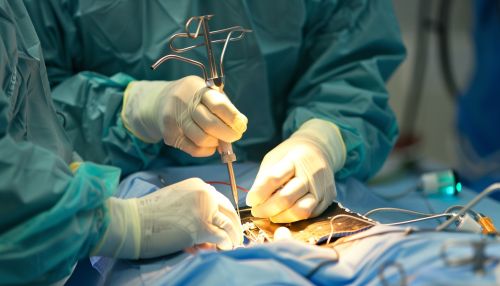Microdiscectomy
Overview
Microdiscectomy, also known as microdecompression or microdiskectomy, is a type of minimally invasive surgical procedure performed on patients with a herniated lumbar disc. During this procedure, a small part of the bone over the nerve root or the disc material from under the nerve root is removed to relieve neural impingement and provide more room for the nerve to heal.
Procedure
A microdiscectomy is performed under general anesthesia. The patient is placed face down on the operating table. The surgeon makes a small incision in the midline of the lower back. After the incision is made, the back muscles (erector spinae) are lifted off the bony arch (lamina) of the spine. They are held in place with retractors, providing the surgeon with a clear view of the bony vertebra and the disc.


The surgeon then removes a small amount of bone and ligament from the back of the spine. This part of the procedure, known as a laminotomy, allows the surgeon to visualize the nerve root. The nerve root is then gently moved to the side.
The surgeon then uses small instruments to remove the disc material from under the nerve root. The procedure is performed using a microscope or other magnifying device to help the surgeon see the affected area more clearly. The back muscles are then placed back over the spine and the incision is closed.
Indications
Microdiscectomy is typically recommended for patients who have experienced symptoms of a herniated disc for at least six weeks and have not found relief from conservative treatments such as physical therapy and medication. Symptoms may include persistent pain, weakness, or numbness in the lower back and legs.
Patients who are good candidates for this procedure are those with a herniated disc that is causing significant nerve root compression. This can be confirmed through imaging studies such as magnetic resonance imaging (MRI) or computed tomography (CT) scans.
Risks and Complications
As with any surgical procedure, microdiscectomy carries some risks. These may include infection, bleeding, nerve damage, or a reaction to anesthesia. There is also a small risk that the disc will herniate again.
In some cases, patients may continue to experience pain or numbness after surgery. This could be due to the presence of scar tissue, damage to the spinal nerve root caused by the disc herniation, or other spinal conditions.
Recovery
Recovery from a microdiscectomy is typically quicker than from more invasive types of spine surgery. Most patients are able to return home the same day or the day after the surgery.
Physical therapy is often recommended to help strengthen the back muscles and prevent future injury. Patients are usually able to return to light activities within a few weeks and more strenuous activities within a few months.
